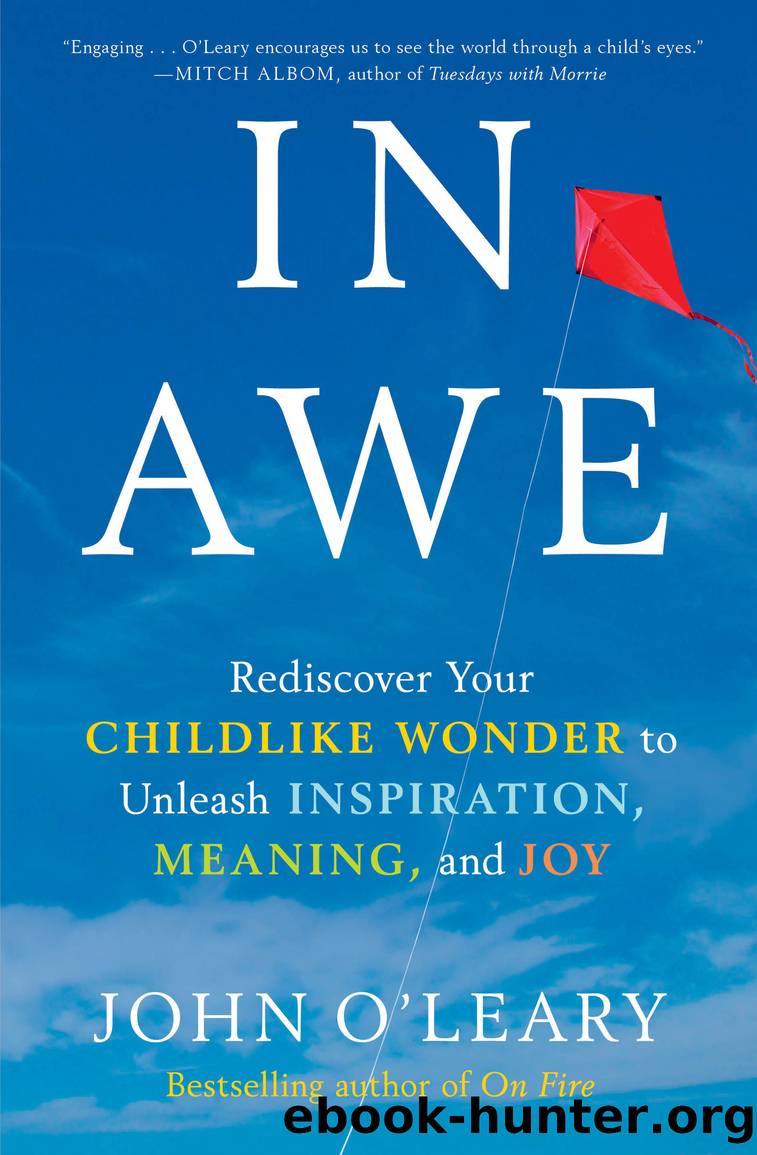In Awe by John O'Leary

Author:John O'Leary [O'Leary, John]
Language: eng
Format: epub
Publisher: Crown
Published: 2020-05-05T00:00:00+00:00
17
Go Fly a Kite
IF MORE OF US VALUED FOOD AND CHEER AND SONG ABOVE HOARDED GOLD, IT WOULD BE A MERRIER WORLD.
J. R. R. Tolkien, The Hobbit
It was dark when I arrived, so the next morning, I hopped out of bed and threw back the curtains of the hotel to see the beautiful ocean just outside my window. I was there only for a day, but man, we just don’t have the beaches in Missouri that they do in Hawaii. I couldn’t wait to stroll down the beach and dip my toes in the ocean.
During my breakfast meeting, I met with some of the conference organizers, who had arrived a few days earlier to get everything prepared. I bounded into the room and asked, “Hey! How’s the water? Is the beach as nice as it looks?”
They stared at me in confusion. Though they were squarely in paradise, not one had removed their shoes, shucked their sports coat, and stepped into the sand. Racing to get ready, they’d been too busy. No one had even looked out the window to notice the Pacific, just within reach.
Conferences are often jam-packed. Schedules get tight. There’s too much to fit into each day.
But do you know what part of the school day is most essential for kids? What pocket of time matters most?
Hint: It’s not math or science. It isn’t reading or writing.
It is recess.
Active playtime allows what happens in the classroom to be much more effective.
A school district in Texas learned this firsthand. Like many other schools across the country, they were struggling to manage students who were being diagnosed with ADHD at increasingly younger ages and had trouble focusing in school. They decided to join a pilot program to see if adding more recess to the school day would improve student outcomes.
Modeling their program after the Finnish school system, which allows elementary school students fifteen minutes of unstructured, outdoor playtime for every forty-five minutes of instruction, the school shifted from providing just twenty minutes of recess for the kindergarten and first-grade students to four fifteen-minute recesses plus a lunch break each school day.
The teachers were initially concerned about the loss of class time, and how they would be able to cover all the required material. But halfway through the pilot year, one first-grade teacher said they were already “way ahead of schedule.”
How could that be? They had less class time, but they were keeping pace and in fact moving more quickly through the material?
Here’s what was happening. The students were less distracted and more engaged. They were less fidgety and making more eye contact with their teachers.
The class time was therefore much more productive.
The designer of the pilot program outlined the many benefits of more frequent recess. They included increased attentional focus, improved academic performance, improved attendance, decreased behavioral diagnoses, and improved creativity and social skill development.1
Not bad for a little extra time on the monkey bars.
Ohio State University pediatrician Bob Murray, who helped write the American Academy of Pediatrics
Download
This site does not store any files on its server. We only index and link to content provided by other sites. Please contact the content providers to delete copyright contents if any and email us, we'll remove relevant links or contents immediately.
| Ethics | Etiquette |
| Fashion & Image | Health & Stress |
| Motivation & Self-Improvement | Work Life Balance |
| Workplace Culture |
Tools of Titans by Timothy Ferriss(6950)
Change Your Questions, Change Your Life by Marilee Adams(6646)
Deep Work by Cal Newport(5471)
Man-made Catastrophes and Risk Information Concealment by Dmitry Chernov & Didier Sornette(4739)
Big Magic: Creative Living Beyond Fear by Elizabeth Gilbert(4727)
The Slight Edge by Jeff Olson(4722)
Digital Minimalism by Cal Newport;(4548)
The Motivation Myth by Jeff Haden(4528)
Stone's Rules by Roger Stone(4418)
Ego Is the Enemy by Ryan Holiday(3994)
The Laws of Human Nature by Robert Greene(3950)
Tuesdays with Morrie by Mitch Albom(3833)
Rising Strong by Brene Brown(3783)
Eat That Frog! by Brian Tracy(3515)
Skin in the Game by Nassim Nicholas Taleb(3465)
The Money Culture by Michael Lewis(3286)
Skin in the Game: Hidden Asymmetries in Daily Life by Nassim Nicholas Taleb(3264)
Believe It to Achieve It by Brian Tracy & Christina Stein(3207)
Bullshit Jobs by David Graeber(3180)
